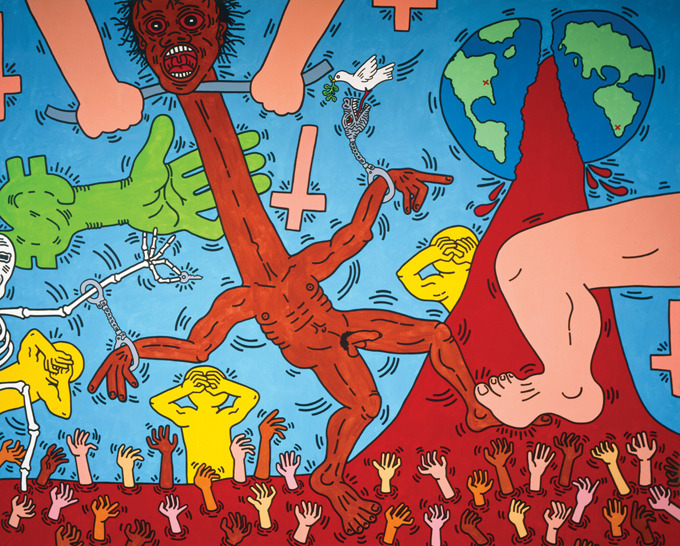An Honest Show of Hands
After New York graffiti artist Michael Stewart died in the hands of police in 1983, Artist Jean-Michel Basquiat famously said “It could have been me. It could have been me.” It was another case of an unarmed black man who died of a heart attack after being beaten by white police officers in the course of his arrest for what seems like a petty offense. Artists from Lou Reed to Keith Haring paid homage to Stewart as a victim of racial bias and brutality by the police. The officers were acquitted by an all white grand jury in 1985.
Everything happens for a reason. And I’m sure that everything always happens at the right time and in the right place. – Keith Haring
So what was the “reason” for the deaths of Michael Stewart, or Michael Brown, or Eric Garner? What was the reason for the police actions or the grand jury decisions? What does it say about racial relations in America when (young) black men are 21 times more likely to be killed by police than white men? Have attitudes and behaviors really changed or is the “original sin” of racism in America still rampant?
On the surface, the the “face of crime” hasn’t changed much in recent years. As FBI statistics show, a decade ago 70% of all arrests were of white people, 27% black. In 2013 whites made up 69% of those arrested, while 28% were black. Yet, as the NAACP points out 1 mio. out of 2.3 mio. Americans incarcerated today (or 43%) are black. Among youth admitted to state prison, 58% are black. From beginning (arrest) to end (prison), the odds seem to be stacked against African Americans.
Criminal justice statistics, though, can’t begin to describe the problem of racial-bias adequately. As New York Time’s David Brooks points out, racial bias is not just a problem of the criminal justice system. Deeper issues of income inequality are at the center of a problem which marginalizes the poor and creates “class prejudice…based on visceral attitudes about competence.” Unlike the American dream world where anyone can make it if they just work hard enough, Brooks describes a world of the haves and have-nots which are increasingly detached and fearful of each other.
In one world, people assume they can control their destinies. In the other, some people embrace the now common motto: “It don’t make no difference.” – David Brooks
So how is it that white graffiti artist Kenny Scharf can be arrested for spray painting in Brooklyn and come away unscathed while Michael Stewart winds up in a grave? Maybe art can help capture the meaning of the moment. At the very least, it can force us to focus squarely on the existence of a problem instead of ignoring its existence. Haring’s Michael Stewart – USA for Africa (image above) or Jean-Michel Basquiat’s Defacement (The Death of Michael Stewart) are two specific reactions to the death of Michael Stewart. More broadly, the 2004 movie Crash by Paul Haggis depicts racial tensions and a mindset that exists within communities of color and in interactions with police, including the now frequently quoted situation of “driving while black.”
If you grow up in a white middle-class neighborhood, you learned that if you stay out of trouble and respect authority then nothing bad would happen even if you did have a run in with the law. Growing up in a black community, however, unfortunately means that you are more likely to come under the suspicious eye of the police. A white person’s drunken encounter with a police officer in the suburbs might lead to a night in jail and a day in court, but a disorderly encounter with the police in a black community might get you “taken down”, hurt or even killed.
These are the differences of circumstances and experience which can lead those like Basquiat to conclude “it could have been me,” while others lacking the same experience just ignore it, shaking their heads in disbelief. Be honest: raise your hand if you’ve ever seen racial prejudice in action but decided to look away.
There are no easy solutions. In an era of 24/7 social and mass media, having a calm and orderly national debate about racial relations is difficult enough. It’s going to take more than public gestures of solidarity by professional athletes going viral to make a difference. Both the media and politicians must go beyond the memes of the day and engage in true introspection and reconciliation. To begin with, it would help if leaders across the political spectrum would come together and acknowledge that historic grievances of the African American community are not a thing of the past or self-inflicted and that they still exist in very tangible ways today.
Protesters must be mindful of the long road ahead, stay peaceful and formulate a constructive agenda to affect change within their communities as well as in the officials and policies that affect them. Maybe then, can we all move beyond suspicion and hatefulness. In the book and movie “Loneliness of the Long Distance Runner” by Alan Sillitoe, the rebellious young character Colin never makes it to the finish line in a race toward reconciliation, stopping short in a moment of reflection about his victimized past. In the end he chooses loneliness and defiance rather than reconciling himself with authority. As understandable as that may be in light of personal experience, I have to believe that it is better in the spirit of Maya Angelou to rise above circumstance in search of a better future.

